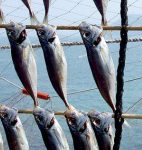Last May, the United States National Marine Fisheries Service (NMFS) – the federal agency responsible for the nation’s marine resources – declared a fishery failure for California’s Sacramento River fall (autumn) Chinook run and closed all commercial and most recreational salmon fishing in the state of California and most of Oregon. It is the country’s most stringent restriction on salmon fishing ever, according to the Pacific Fishery Management Council, one of eight regional organisations that oversee fisheries in the United States.
The closure is expected to have a dramatic impact on local anglers, but not on international trade, because the bulk of the U.S. harvest comes from Alaska. Local anglers affected by the closure in California and Oregon will lose the vast majority of their expected earnings: US$36 million for commercial anglers, and $24 million for their recreational counterparts, according to NMFS. Dependent local businesses, such as retailers, wholesalers and distributors, guides, charter captains, motels and restaurants, will also be affected.
The closure affects a small portion of the many populations of salmon, which are differentiated by species, birth river and time of year they spawn. But other populations are also endangered or in jeopardy. Most rivers historically had three runs a year: spring, fall and winter. But according Allen Grover, chair of the salmon technical team at the Pacific Fishery Management Council, when large dams were built across rivers in the western United States, between the 1930s and 1960s, spring and winter runs decreased dramatically. Fall-run fish have been more successful because they have spawned historically in bigger rivers that are closer to the ocean.
On the Sacramento River fall Chinook run, fisheries managers aim for about 150,000 salmon to return each year, the amount they believe the existing habitat can support. But in 2007, just 88,000 returned, and the projection for 2008 is 59,000, a number that inspired the fishery closure.
What is to blame?
One theory blames the failure on a change in oceanic conditions. Temperatures and currents are variable from year to year, as is the upwelling, a crucial swirl of krill that forms the base of the food chain. Scientists say the upwelling came too late in 2005, the year when most of today’s adult fish arrived in the ocean. Because the Sacramento fall Chinook have a three- to four-year life cycle, the 2005 young salmon, known as smolt, should have returned in 2007 or 2008. But experts agree there are many more factors affecting salmon health, and some say the ocean conditions theory is a dodge.
“A lot of the politicians want to try to avoid accountability by just saying, ‘gee whiz, we just can’t control that stuff’,” said Jim Martin, a retired fisheries biologist and current conservation director for Pure Fishing, a fishing tackle company. “But in fact, political decisions in freshwater affect these fish tremendously and set them up for disaster.”
Water extraction for arid southern California appears to be the dominant factor in the Sacramento failure, said Martin. In 2005, the federal Central Valley Project, the State Water Project of California and two municipal districts increased water allocations to 6.4 million acre feet – almost 7.9 billion cubic metres – the most water ever removed in a single year, according to John McManus, media director for the environmental law firm Earthjustice. McManus believes the 2005 smolt didn’t make it to the ocean that year. “They were no-shows,” he said.
The amount of water extracted that year seems to be a tipping point. Although data is not yet available, “the 6.4 million acre feet in 2005 is a smoking gun,” said McManus. In the late 1980s, extraction was near the 6 million acre feet mark (7.4 billion cubic metres) three years running, he said, and there was a salmon crash in 1992.
Dave Sones, the American Indian appointment to the Pacific Fisheries Management Council, said water managers also need to consider natural variability. “It’s a moving target with water, depending on weather conditions,” he said.
Teresa Geimer, supervising engineer with the California Department of Water Resources, contends that its deliveries any given year depend on its water rights, hydrology and legal constraints to protect the environment.
While water use in cities such as Los Angles and San Diego gets a lot of press attention, in fact, 85% of the extracted water is going to agriculture in the San Joaquin Valley, central California’s farming belt, according to McManus. Many argue it is not used wisely.
“I can understand withdrawing water for important food crops,” said Martin. “I cannot understand spreading water on the desert at the expense of a collapsing ecosystem to grow more subsidised cotton in the desert.”
Besides dams and water extraction, other freshwater habitat factors also impact salmon health.
A high percentage of salmon are hatchery raised, and changes in the handling of hatchery fish can also affect populations. In 2005 and 2006, the California Department of Fish and Game did not release smolt into acclimation pens, as they have typically done. Instead, they released them directly into the bay, where they were likely easy prey for predatory birds and fish.
Other factors that affect salmon health are continuous and not specific to 2005.
“Removal of riparian vegetation [river-bank trees, for example] raises water temperatures by increasing silt loads,” said Brad Gentner, president of Gentner Consulting Group, which specialises in natural resources economics.
Suburban sprawl also hurts salmon because paved areas speed polluted runoff into water bodies. Improper sewage treatment can also be a factor, as is agricultural runoff, which contains fertilisers and pesticides.
Negotiations among the many constituencies – loggers, farmers, city governments and anglers – have been going on for decades and have reached some agreements. But activists argue that it is not enough.
“We’re tinkering around the politically acceptable edge of the problem,” said Martin of Pure Fishing. “We’re doing lots of things that are politically popular that will help the salmon survive the decade. We’re doing almost nothing that will help salmon survive the century.” As the human population continues to grow and climate change affects ecosystems, demand for power and water are likely to increase, said Martin.
Because California’s Sacramento River is at the south end of the salmon range, climate change will likely hit its runs hardest, said Natalie Brandon, communications director for conservation group Save Our Wild Salmon. “The water is warming up from climate change. They need really cold water to be able to thrive, and increasingly, they’re just not getting that.”
With all these habitat issues affecting salmon populations, anglers believe the fishing moratorium is misguided. “A lot of commercial fishermen feel scapegoated because they’re a smaller, more defined interest group,” said Gentner. “[Urban developers and the timber and agriculture industries] are much bigger and generate far more dollars than commercial fishing does…. The guys with most money have the loudest voices and get heard.”
Detrimental impacts on salmon health are less of an issue in Alaska, with its largely untamed rivers, vast territory and sparse population, than in places like California. As a result, the majority of U.S. fish harvests – and exports – come from Alaska. For example, in 2006, the United States exported 39,014 tonnes of salmon to China, generating US$115 million, according to the NMFS. Of that, 20,466 tonnes came from Alaska and 18,471 tonnes from Washington. Because those states are not affected by the current closure in California and Oregon, exports to China are unlikely to be affected much.
China is also a major re-processor of fish. The United States sells gutted fish to China, where they are cut and repackaged for sale elsewhere, often back in the United States. The same year the United States exported the 39,014 tonnes to China, it imported 26,482 tonnes from that country.
If the price of oil continues to rise, this arrangement may not remain economically viable for long.
As for the salmon and the industries they support, their sustainability is far from assured. “We play all sorts of silly games to keep these interest groups happy,” said Gentner. “And in the end, the resource loses.”
Erica Gies is a freelance environmental reporter based in San Francisco. Her stories have appeared in the International Herald Tribune, World Watch magazine, San Francisco Chronicle online, Grist.org, and more.
Homepage photo by Patrick Dirden



